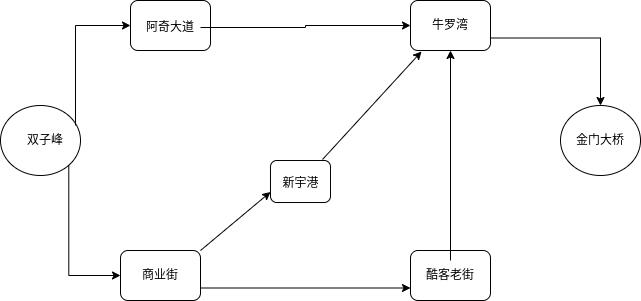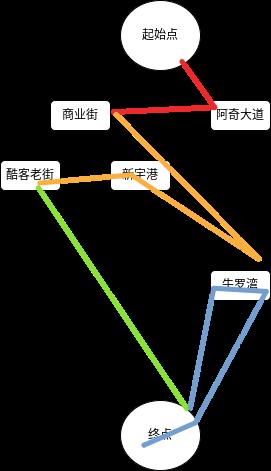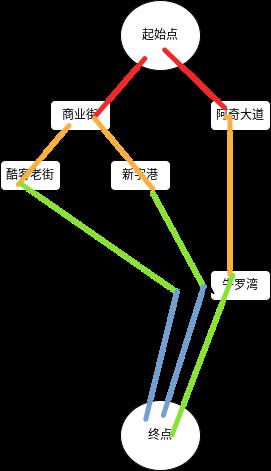广度搜索和深度搜索
Posted NETWORKIP
tags:
篇首语:本文由小常识网(cha138.com)小编为大家整理,主要介绍了广度搜索和深度搜索相关的知识,希望对你有一定的参考价值。
广度搜索和深度搜索
最短路径问题
我现在要从“双子峰” 前往 “金门大桥” ,求最短的路径

根据图建立树
根据图建立二叉树模型
package DataStructure.FS;
public class PlaceTree
//存储当前地址
String place;
//左孩子节点
PlaceTree leftPlace;
//右孩子节点
PlaceTree rightPlace;
//无参构造方法
public PlaceTree()
//带单独参构造方法
public PlaceTree(String p)
place = p;
//带全参的构造方法
public PlaceTree(PlaceTree left,PlaceTree right,String p)
//放置左孩子
leftPlace = left;
//放置右孩子
rightPlace = right;
//放置位置
place = p;
实现二叉树
public static void main(String[] args)
PlaceTree szf = new PlaceTree("双子峰");
PlaceTree aqdd = new PlaceTree("阿奇大道");
PlaceTree syj = new PlaceTree("商业街");
PlaceTree llw = new PlaceTree("牛罗湾");
PlaceTree xyg = new PlaceTree("新宇港");
PlaceTree kklj = new PlaceTree("酷客老街");
PlaceTree jmdq = new PlaceTree("金门大桥");
//创建节点
szf.leftPlace = aqdd;
szf.rightPlace = syj;
aqdd.rightPlace = llw;
syj.leftPlace = xyg;
syj.rightPlace = kklj;
xyg.rightPlace = llw;
kklj.rightPlace = llw;
llw.rightPlace = jmdq;
//设置关系
System.out.println("广度优先遍历结果:");
new PlaceBFS().BroadFirstSearch(szf);
System.out.println("深度优先遍历结果:");
new PlaceBFS().DepthFirstSearch(szf);
实现 BFS 广度搜索
public void BroadFirstSearch(PlaceTree nodeHead)
//如果节点为空,返回
if(nodeHead == null)
return;
//以队列的方式 (FIFO) 实现广度搜索
Queue<PlaceTree> myQueue = new LinkedList<>();
myQueue.add(nodeHead);
//将节点压入队列
while(! myQueue.isEmpty())
PlaceTree node = myQueue.poll();
System.out.print(node.place + " ");
if (null != node.leftPlace)
myQueue.add(node.leftPlace);
//有左孩子就压左孩子
if (null != node.rightPlace)
myQueue.add(node.rightPlace);
//有右孩子就压有孩子
//呈现右孩子和右孩子都压入队列中的情况,这样说好恐怖。
实现 DFS 深度搜索
public void DepthFirstSearch(PlaceTree nodeHead)
if(nodeHead == null)
return;
//以堆栈 (LIFO) 实现深度搜索
Stack<PlaceTree> myStack = new Stack<>();
myStack.add(nodeHead);
while(! myStack.isEmpty())
PlaceTree node = myStack.pop();
System.out.print(node.place+" ");
if(node.rightPlace != null)
myStack.push(node.rightPlace);
//如果右节点不为空就压入
if(node.leftPlace != null)
myStack.push(node.leftPlace);
//如果左节点不为空就压入
//左节点后压入,左节点后出
BFS 和 DFS 源代码
package DataStructure.FS;
import java.util.LinkedList;
import java.util.Queue;
import java.util.Stack;
public class PlaceBFS
public static void main(String[] args)
PlaceTree szf = new PlaceTree("双子峰");
PlaceTree aqdd = new PlaceTree("阿奇大道");
PlaceTree syj = new PlaceTree("商业街");
PlaceTree llw = new PlaceTree("牛罗湾");
PlaceTree xyg = new PlaceTree("新宇港");
PlaceTree kklj = new PlaceTree("酷客老街");
PlaceTree jmdq = new PlaceTree("金门大桥");
//创建节点
szf.leftPlace = aqdd;
szf.rightPlace = syj;
aqdd.rightPlace = llw;
syj.leftPlace = xyg;
syj.rightPlace = kklj;
xyg.rightPlace = llw;
kklj.rightPlace = llw;
llw.rightPlace = jmdq;
//设置关系
System.out.println("广度优先遍历结果:");
new PlaceBFS().BroadFirstSearch(szf);
System.out.println();
System.out.println("深度优先遍历结果:");
new PlaceBFS().DepthFirstSearch(szf);
public void BroadFirstSearch(PlaceTree nodeHead)
//如果节点为空,返回
if(nodeHead == null)
return;
//以队列的方式 (FIFO) 实现广度搜索
Queue<PlaceTree> myQueue = new LinkedList<>();
myQueue.add(nodeHead);
//将节点压入队列
while(! myQueue.isEmpty())
PlaceTree node = myQueue.poll();
System.out.print(node.place + " ");
if (null != node.leftPlace)
myQueue.add(node.leftPlace);
//有左孩子就压左孩子
if (null != node.rightPlace)
myQueue.add(node.rightPlace);
//有右孩子就压有孩子
//呈现左孩子和右孩子都压入队列中的情况,这样说好恐怖。
public void DepthFirstSearch(PlaceTree nodeHead)
if(nodeHead == null)
return;
//以堆栈 (LIFO) 实现深度搜索
Stack<PlaceTree> myStack = new Stack<>();
myStack.add(nodeHead);
while(! myStack.isEmpty())
PlaceTree node = myStack.pop();
System.out.print(node.place+" ");
if(node.rightPlace != null)
myStack.push(node.rightPlace);
//如果右节点不为空就压入
if(node.leftPlace != null)
myStack.push(node.leftPlace);
//如果左节点不为空就压入
//左节点后压入,左节点后出
结果
广度优先遍历结果:
双子峰 阿奇大道 商业街 牛罗湾 新宇港 酷客老街 金门大桥 牛罗湾 牛罗湾 金门大桥 金门大桥
深度优先遍历结果:
双子峰 阿奇大道 牛罗湾 金门大桥 商业街 新宇港 牛罗湾 金门大桥 酷客老街 牛罗湾 金门大桥
BFS 和 DFS 搜索方式
为什么深度优先搜索的结果更好,下图分析:
BFS的搜索步骤图

BFS 有点像横向的分层。
“起点”、“商业街”和“阿奇大道”为一层,
“酷客老街”、“新宇港”和“牛罗湾”为第二层,
“牛罗湾”和“终点”为第三次层,“终点”为第四层。
DFS的搜搜步骤图

DFS 有点向竖向的分列。
“起点”、“阿奇大道”、“牛罗湾”、“终点” 为一列,得到最短解。
"起点"、“商业街”、“新宇港”、“牛罗湾”、“终点”为一列,得到第二种解。
“商业街”、“酷客老街”、“牛罗湾”、“终点”为一列,得到第三种解。
以上是关于广度搜索和深度搜索的主要内容,如果未能解决你的问题,请参考以下文章